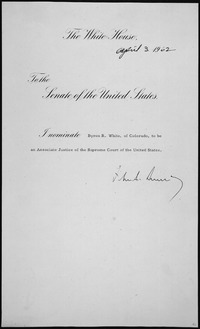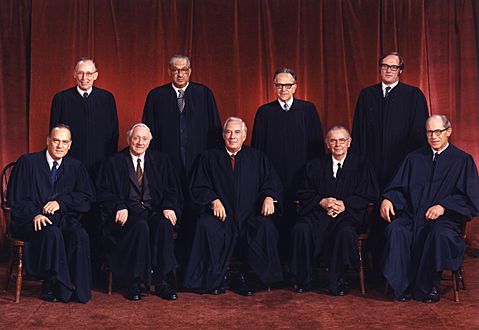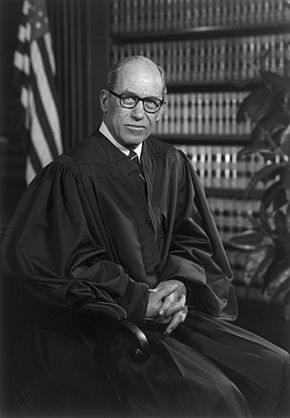Byron White facts for kids
Quick facts for kids
Byron White
|
|||||||
|---|---|---|---|---|---|---|---|
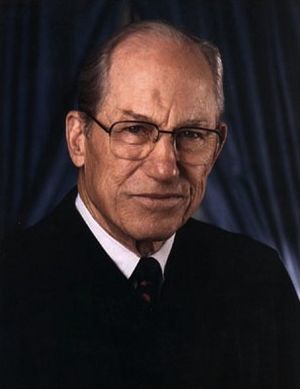 |
|||||||
| Associate Justice of the Supreme Court of the United States | |||||||
| In office April 16, 1962 – July 1, 1993 |
|||||||
| Nominated by | John F. Kennedy | ||||||
| Preceded by | Charles Evans Whittaker | ||||||
| Succeeded by | Ruth Bader Ginsburg | ||||||
| 6th United States Deputy Attorney General | |||||||
| In office January 20, 1961 – April 12, 1962 |
|||||||
| President | John F. Kennedy | ||||||
| Preceded by | Lawrence Walsh | ||||||
| Succeeded by | Nicholas Katzenbach | ||||||
| Personal details | |||||||
| Born |
Byron Raymond White
June 8, 1917 Fort Collins, Colorado, U.S. |
||||||
| Died | April 15, 2002 (aged 84) Denver, Colorado, U.S. |
||||||
| Resting place | Saint John's Cathedral | ||||||
| Political party | Democratic | ||||||
| Spouse |
Marion Stearns
(m. 1946) |
||||||
| Relations | Clayton Samuel (brother) | ||||||
| Education | University of Colorado Boulder (AB) Hertford College, Oxford Yale University (LLB) |
||||||
| Civilian awards | Presidential Medal of Freedom (2003) | ||||||
| Signature | |||||||
| Military service | |||||||
| Allegiance | |||||||
| Branch/service | |||||||
| Years of service | 1942–1945 | ||||||
| Rank | |||||||
| Unit | Office of Naval Intelligence | ||||||
| Battles/wars |
|
||||||
| Military awards | |||||||
|
Football career |
|||||||
| No. 24 | |||||||
| Position: | Halfback | ||||||
| Personal information | |||||||
| Height: | 6 ft 1 in (1.85 m) | ||||||
| Weight: | 187 lb (85 kg) | ||||||
| Career information | |||||||
| High school: | Wellington (Colorado) | ||||||
| College: | Colorado (1935–1937) | ||||||
| NFL Draft: | 1938 / Round: 1 / Pick: 4 | ||||||
| Career history | |||||||
|
|||||||
| Career highlights and awards | |||||||
|
|||||||
| Career NFL statistics | |||||||
|
|||||||
| Player stats at PFR | |||||||
|
College Football Hall of Fame
|
|||||||
Byron "Whizzer" Raymond White (June 8, 1917 – April 15, 2002) was an amazing American who was a lawyer, a judge, and a professional football player. He served as an associate justice on the Supreme Court of the United States from 1962 to 1993. When he retired, he was the only judge on the Court who was a Democrat.
Byron White grew up in a small town in Wellington, Colorado. He was known for being a very smart student and a great athlete. He came from a family of humble beginnings but became an All-American halfback for the Colorado Buffaloes college football team.
After college, he was picked in the 1938 NFL Draft by the Pittsburgh Pirates. He led the NFL in rushing yards in his first season. White also studied very hard and graduated at the top of his class from the University of Colorado Boulder. He even earned a special scholarship called a Rhodes Scholarship to study at Oxford University in England.
During World War II, he returned to the United States. He played for the Detroit Lions football team while also studying at Yale Law School. He then served as an intelligence officer for the United States Navy in the Pacific Ocean. After the war, White finished law school with high honors. He then worked as a law clerk for the Chief Justice of the Supreme Court.
Later, he returned to Colorado to work as a lawyer. He helped with John F. Kennedy's presidential campaign in 1960. This led to him being chosen as the United States Deputy Attorney General in 1961. The next year, President Kennedy nominated him to the Supreme Court. He became the first justice from Colorado.
Contents
Byron White's Early Life and School
Growing Up in Colorado
Byron Raymond White was born in Fort Collins, Colorado, on June 8, 1917. He was the younger son of Maude Elizabeth and Alpha Albert White. Even though his parents had not finished high school, they strongly believed in education. They were also active in their local community.
Byron and his older brother, Clayton "Sam" Samuel White, grew up in Wellington, Colorado. They both went to the local high school. As a young student, Byron worked many odd jobs to help his family. These jobs included harvesting beets, shoveling coal, and doing construction work.
His brother Sam was also a great student and athlete. Sam graduated at the top of his class and earned a scholarship to the University of Colorado Boulder. He later became a Rhodes Scholar. While Sam was outgoing, Byron was described as quiet and thoughtful.
Byron did very well in high school. He graduated in 1934 at the top of his small class of six students. He had the highest grades in the school's history. He studied hard to get a college scholarship. He later said his rule in Wellington was "do your work and don't be late for dinner."
Byron followed his brother to the University of Colorado Boulder. He received a scholarship given to all Colorado high school students who were valedictorians (top of their class). He planned to study chemistry and go to medical school. He focused on his studies and became a star athlete. He played as an All-American halfback for the Colorado Buffaloes football team. He led his team to many victories and became one of the most famous players in the country.
In 1935, Sam White won a Rhodes Scholarship to study at Oxford University. Byron was inspired by his brother's success and wanted to achieve the same. In his senior year, Byron became student body president. He changed his major to humanities and graduated with high honors from the University of Colorado in 1938. He earned a Bachelor of Arts degree in economics.
In his last year, the Colorado Buffaloes football team had a perfect season. Byron's football fame earned him the nickname "Whizzer White" from the student newspaper. After months of studying, Byron also won the Rhodes Scholarship. He decided to play professional football for a year before going to Hertford College.
Studying at Oxford University
On January 3, 1939, Byron White traveled to England. He arrived on January 9 and was met by reporters who wanted to see a "Yank at Oxford." He moved into Hertford College to study law. He became friends with future mathematician George Piranian.
White spent his days at Oxford studying very hard, often for fourteen hours a day. During one break, he met Joseph P. Kennedy and future U.S. President John F. Kennedy. Their father, Joseph Kennedy, was the U.S. ambassador in London.
Just before World War II began, Oxford students were very interested in international politics. Many American Rhodes Scholars urged President Roosevelt to act against certain groups. However, White stayed out of politics. He focused on his studies and staying fit.
After a term, White spent a summer traveling in France and Germany. He settled in Munich to study German and Roman law. He unexpectedly met John F. Kennedy again, who was also touring Europe. One time, a crowd recognized their English license plates and heckled them. As the war made it impossible for students to study abroad, White left Europe in August 1939. He decided to continue his legal education at Yale Law School.
Law School and Pro Football
When he started at Yale, White continued his routine of studying fourteen hours a day. He took breaks only to exercise in the gym. He often played basketball there. The New York Giants and other NFL teams tried to get him to play football again. But White publicly said his football days were over and he was starting a law career.
White earned the highest grades in his first year at law school. He won an award for being the top first-year student. During the summer, he returned to Colorado. He attended summer school and worked as a waiter at his old fraternity.
White turned down an offer to join the Yale Law Journal. Instead, he took a break from law school to play professional football again for the Detroit Lions. He led the league in rushing yards again in 1940. In three NFL seasons, he played in 33 games. He led the NFL in rushing yards in 1938 and 1940. He was the highest-paid player in the NFL at the time.
At the end of the 1941 season, he returned to Yale. He was waiting for a call to serve in the U.S. Navy after the Attack on Pearl Harbor. In May 1942, he was assigned to naval intelligence. He trained for weeks in Dartmouth College and New York City. He had wanted to join the Marines Corps, but he couldn't because he was colorblind.
Serving in World War II
In July 1943, White was stationed in Nouméa, New Caledonia. His job was to protect Guadalcanal and Tulagi. He almost served with John F. Kennedy, who had also been stationed nearby. During World War II, White was an intelligence officer in the Navy. He served in the Pacific Ocean.
He wrote the intelligence report about the sinking of future President John F. Kennedy's boat, the PT-109. For his service, White received two Bronze Star medals. He was honorably discharged as a lieutenant commander in 1945.
Byron White's Legal Career
After his military service, White returned to Yale Law School. He graduated in 1946 at the top of his class with a law degree, earning high honors. He was also part of a special law honor society.
White worked as a law clerk for Chief Justice Fred M. Vinson of the U.S. Supreme Court from 1946 to 1947. Then, he went back to Colorado. He started working as a lawyer in Denver with a law firm. This was a time when Denver's economy was growing. White helped businesses with contracts and advised companies. He also argued cases in court sometimes.
During the 1960 presidential election, White used his fame as a football star to help John F. Kennedy's campaign in Colorado. White had first met Kennedy when White was a Rhodes Scholar and Kennedy's father was the U.S. Ambassador in London.
During Kennedy's time as president, White served as United States Deputy Attorney General. This was the second-highest position in the Justice Department, working under Robert F. Kennedy. In 1961, he played a key role in protecting the Freedom Riders. He negotiated with the Governor of Alabama to ensure their safety.
Becoming a Supreme Court Justice
On April 3, 1962, President Kennedy nominated White to be an associate justice of the Supreme Court. He was replacing Charles Evans Whittaker. President Kennedy, who had known White for a long time, said that White had "excelled at everything." He believed White would also do great on the highest court in the country.
White was confirmed by a voice vote on April 11, 1962. He took his oath of office on April 16, 1962. He served on the Supreme Court until June 28, 1993. His time on the Supreme Court was the fourth-longest in the 20th century.
On January 20, 1993, Vice President-Elect Al Gore asked White to administer his oath of office. This was the only time White swore in a vice president. During his time on the Court, White wrote 994 opinions. He was known for asking tough questions to lawyers in court. His decisions and opinions on the bench were hard for people to label as strictly liberal or conservative. Some Kennedy supporters were disappointed because they wished he had joined the more liberal side of the court on cases like Miranda v. Arizona and Roe v. Wade.
White often looked at cases very specifically, based on the facts. He usually avoided making big statements about constitutional rules. He preferred a practical way of looking at the law. He often supported a broad view of government powers, following the ideas of the New Deal. He often voted against creating new rules that would limit the police. For example, he disagreed with the important 1966 case Miranda v. Arizona. In his disagreement, he said that strong police actions help protect the rights of law-abiding citizens. Some people praised his approach for sticking to the idea of judicial restraint, which means judges should not make new laws but only interpret existing ones.
Views on the Death Penalty
White had a balanced view on the death penalty. In Furman v. Georgia (1972), he was one of five justices who voted to stop several state death penalty laws. He was worried about how unfairly the death penalty was being used. The Furman decision stopped capital punishment in the U.S. for a few years. Later, in Gregg v. Georgia (1976), White voted to support Georgia's new death penalty law, which allowed it again.
Supporting Civil Rights
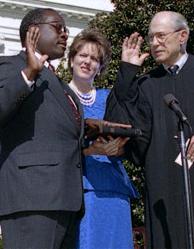
White consistently supported the Court's efforts to fully desegregate public schools after the Brown v. Board of Education case. This included supporting controversial cases about forced busing. He also voted to support affirmative action plans to help achieve racial equality in education. This happened in the famous Regents of the University of California v. Bakke case in 1978.
White also supported federal affirmative action programs in some cases. However, he voted against an affirmative action plan for state contracts in Richmond v. J.A. Croson Co. (1989).
He disagreed with the decision in Runyon v. McCrary (1976). This case said that federal law stopped private schools from discriminating based on race. White argued that the law was not meant to stop private discrimination, only discrimination supported by the state. He worried that stopping private racial discrimination could lead to banning many groups that chose to be separate, like social clubs for specific races.
Working with Other Justices
White said he felt most comfortable on Chief Justice Rehnquist's court. He once said about Chief Justice Earl Warren, "I wasn't exactly in his circle." On the Burger Court, the chief justice often gave important cases about criminal procedures and individual rights to White. This was because White often had more conservative views on these topics.
His Work on the Court and Retirement
White often encouraged the Supreme Court to hear cases where federal appeals courts disagreed on federal law issues. He believed that resolving these disagreements was a main job of the Supreme Court. Because of this, White voted to hear more cases than many of his colleagues. He also wrote many opinions disagreeing when the Court decided not to hear a case. After White retired, the number of cases the Court heard each year dropped significantly.
White did not like the politics involved in choosing Supreme Court justices. But he had great faith in democracy. When people complained about politicians, he would tell them to "get more involved and help fix it." He retired in 1993, during Bill Clinton's presidency. He said that "someone else should be permitted to have a like experience." When he retired, White was the only Democrat on the Court. President Clinton nominated Justice Ruth Bader Ginsburg to take his place. She was a judge and a former law professor.
Later Life and Passing Away
After leaving the Supreme Court, White sometimes served as a judge in lower federal courts. He kept an office in the federal courthouse in Denver until shortly before he passed away. He also worked for a commission that looked at ways to improve the federal appeals courts.
White passed away from pneumonia on April 15, 2002, at the age of 84. He was the last living justice who had served on the Warren Court. He was also the last justice appointed by President Kennedy. He died the day before the fortieth anniversary of his swearing-in as a Justice. From his death until Sandra Day O'Connor retired in 2006, there were no living former justices.
His remains are buried at the St. John's Cathedral in Denver.
Chief Justice Rehnquist said that White "came as close as anyone I have known to meriting Matthew Arnold's description of Sophocles: 'He saw life steadily and he saw it whole.' All of us who served with him will miss him."
Byron White's Family Life
White first met his wife, Marion Stearns (1921–2009), when she was in high school. Her father was the president of the University of Colorado, where White was a college football player. During World War II, Marion served in the WAVES (Women Accepted for Volunteer Emergency Service) while Byron was a Navy intelligence officer. They married in 1946. They had two children: a son named Charles Byron (Barney) and a daughter named Nancy.
His older brother, Clayton Samuel "Sam" White (1912–2004), was also a high school valedictorian and a Rhodes Scholar. He later became a physician and medical researcher. He studied the effects of atomic bomb blasts.
Awards and Special Recognitions
The NFL Players Association gives the Byron "Whizzer" White NFL Man of the Year Award to one player each year for their charity work. Michael McCrary, who was involved in the Runyon v. McCrary case, grew up to be a professional football player and won this award in 2000.
| Of all the athletes I have known in my lifetime, I'd have to say Whizzer White came as close to anyone to giving 100 percent of himself when he was in competition. |
| — Pittsburgh Pirates owner Art Rooney |
The federal courthouse in Denver is named after White. This building houses the Tenth Circuit court.
White was chosen for the College Football Hall of Fame in 1952.
He was also made an honorary fellow of Hertford College, Oxford.
White was given the Presidential Medal of Freedom in 2003 by President George W. Bush after he passed away. This is one of the highest civilian awards in the United States.
White was inducted into the Rocky Mountain Athletic Conference Hall of Fame on July 14, 2007. He is also a member of the College Football Hall of Fame and the University of Colorado's Athletic Hall of Fame. There, he is known as "The Greatest Buff Ever."



